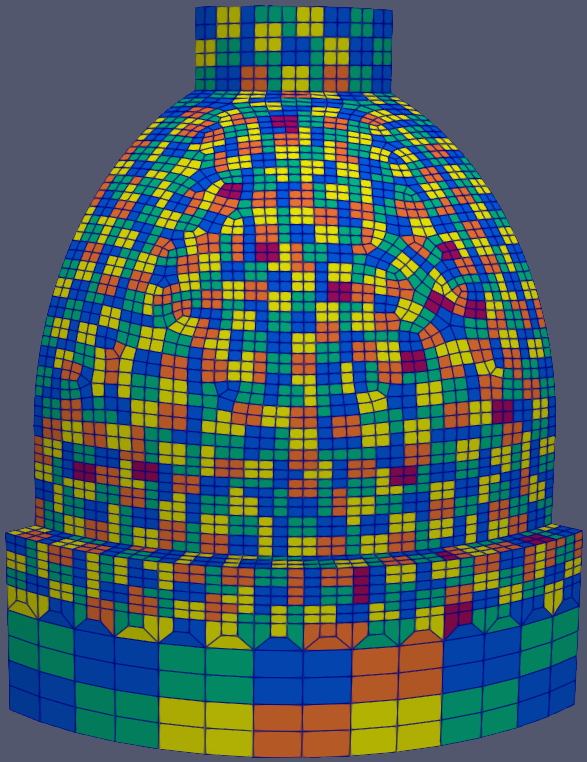PATCHES Namelist
The PATCHES namelist defines the parameters used by the patching algorithms. The namelist supports many parameters, but not all parameters are used by all algorithms. Parameters only used by a particular algorithm are prefixed with the algorithm’s name. These parameters are described in detail below.
- Required/Optional:
Optional
- Single/Multiple Instances:
Single
General Guidance
Genre’s patching allows the Chaparral library to group faces together into patches. This has two main purposes, both especially useful in large problems:
To reduce the output file size. In many scenarios, the radiation enclosure output produced by Genre is prohibitively large (on the order of 100s of GB). It can take a very long time to write these files to disk, or it may be impossible for Truchas to fit into memory.
To reduce the need for very high hemicube_resolution on fine meshes. As face mesh resolution increases, increasingly fine
hemicube_resolutionis needed to resolve view factors. This quadratically increases the genre runtime. By grouping faces into patches, the need for highhemicube_resolutionis less.
Genre offers several patching algorithms, but for most situations, the
'METIS' algorithm (default) is the best choice for speed, accuracy, and
simplicity. The metis_face_patch_ratio can be tuned as needed. A sample input
is given below, and is considered a good starting point for most problems. One
should always view the patches using Vizre to
assess their quality.
&PATCHES
metis_face_patch_ratio = 4
/
Example PATCHES namelist

Result of patching on the ‘basic hemi’ enclosure.
Components
METIS Parameters
The following namelist parameters apply only to the METIS algorithm. For more information, refer to the METIS algorithm documentation.
The METIS algorithm constructs the weighted dual graph of the enclosure and passes it to the METIS library [1] to partition the dual graph. The METIS namelist parameters are thus divided into two: those that are used to construct the dual graph, and those that are passed directly to the METIS graph partitioner.
We first discuss the three parameters used during initialization, and then briefly present the 12 METIS library parameters passed to the graph partitioner.
metis_face_patch_ratio
Defines the ratio of total faces to total desired patches, and by extension the final number of patches generated.
- Type:
real
- Default:
4.0
- Valid Values:
\(\geq 1.0\)
This parameter determines the number of partitions \(N_p\) passed to the METIS graph partitioner:
where \(N_f\) is the total number of faces and \(R\) is the
metis_face_patch_ratio. Since the METIS library is free to produce less
partitions than requested, \(N_p\) is not necessarily the final number of
patches.
The METIS library must ensure that the constraints on the objective function are satisfied (see partitioning objective), and can thus produce a drastically different number of partitions than requested. In particular, when metis_face_weight is enabled for an enclosure with faces of vastly different sizes, the requirement to evenly divide the total enclosure surface area among the patches might produce significantly fewer partitions than requested.
Moreover, after the METIS library partitions the dual graph the patch splitting step breaks up disconnected patches which may increase the final patch count. In short, \(N_p\) is only a suggestion for the final patch count. Consider tweaking other parameters if an exact patch count is desired.
metis_edge_weight
Determines whether to weight the edges of the dual graph by the corresponding enclosure edge lengths.
- Type:
logical
- Default:
True
This parameter determines whether the Euclidean length of the enclosure edges are assigned as edge weights in the dual graph passed to the METIS library. If the parameter is false, then the dual graph edges are assigned a weight of 1.
Refer to the edge weight section of the METIS algorithm documentation for more information on how the parameter affects the final patch configuration.
metis_face_weight
Determines whether to weight the vertices of the dual graph by the corresponding enclosure face areas.
- Type:
logical
- Default:
True
This parameter determines whether the area of the enclosure faces are assigned as vertex weights in the dual graph passed to the METIS library. If the parameter is false, then the dual graph vertices are assigned a weight of 1.
Refer to the face weight section of the METIS algorithm documentation for more information on how the parameter affects the final patch configuration.
metis_ncuts
Specifies the number of different partitionings that will be computed. The final partitioning will be the one that achieves the best edge-cut or communication volume.
- Type:
integer
- Default:
1
- Valid Values:
\(\geq 1\)
metis_seed
Specifies the seed for the random number generator.
- Type:
integer
- Default:
-1
Note
With the default option, patches are not deterministic (depending on the platform). If it is necessary for two runs with identical input to produce identical output, set this parameter.
metis_ufactor
Specifies the maximum allowed load imbalance among the partitions. A value of \(n\) indicates that the allowed load imbalance is \((1+n)/1000\).
- Type:
integer
- Default:
1 for recursive bisection (i.e., an imbalance of 1.001); 30 for \(k\)-way partitioning (i.e., an imbalance of 1.03).
- Valid Values:
\(\geq 1\)
Note
For large enclosures, this parameter can be useful to give METIS more leeway in optimizing the patches.